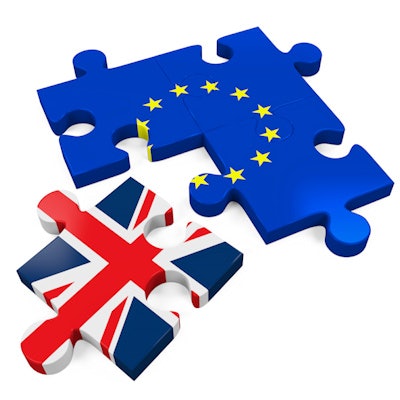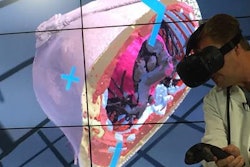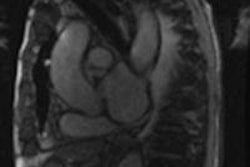
The political bluster and scaremongering is in full flow. Across Europe, the countdown to the U.K. referendum on whether to remain in or leave the European Union (EU) is fast approaching. "Business as usual" or "the great unknown" beckons after the vote on 23 June, depending on which side you listen to.
If Brexit (British exit) wins the day, what are the implications for the medical imaging and healthcare IT industry?
Uncertainty is likely to be the main outcome. Few economists, politicians, or lawmakers have come close to painting a clear picture of the likely consequences, let alone offered a nuanced prediction of impact by industry. The complexity and endless potential outcomes of external market influences make this task nigh on impossible; a "perfect storm" of a brief, enough to finish off any consultant or advisor tasked with a viable outcome.
Well, batten down the hatches, it's about to get rough around here.
Brexit ground zero
If we assume a "leave" vote is confirmed, what will change? Not a huge amount, at least initially, one would suspect. MRI machines will not suddenly stop working and the National Health Service (NHS) will continue to operate and care for the sick. Frankly, little obvious change will be evident in the first few months, apart from a far bigger queue at the Eurostar Business Class lounge for a free glass of Prosecco, as diplomats endlessly pour back and forth between London and Brussels.
 If Brexit goes ahead, the free Prosecco on Eurostar will be flowing.
If Brexit goes ahead, the free Prosecco on Eurostar will be flowing.Change instead will be more subtle. U.K. subsidiaries of major imaging and IT vendors will have to navigate a mountain of regulatory red tape and new import regulations, slowing order fulfillment. All EU-wide regulations, from technical specification to patient safety, will have to be reviewed, re-established, and re-worked into U.K. regulations.
The NHS will undergo a raft of reviews, with major concerns highlighted around staffing (recent figures suggest more than 100,000 NHS employees are European migrants) and procurement of equipment and devices. New equipment and service contracts will be put on hold or cancelled, increasing the lifespan of currently installed imaging equipment. Healthcare IT implementation initiatives will slow.
All the while, U.K. radiologists will avidly scan their emails to see if they are invited back to Vienna for ECR 2017; the organizers of the U.K. Radiological Congress (UKRC) no doubt will plan their biggest conference ever.
The wider implications
Across the channel, the EU will also start to feel the impact of a long, drawn-out Brexit.
As a top three country market for medical imaging and healthcare IT by revenue, the U.K. market slowdown will have a big impact on the bottom line of major imaging and health IT vendors. At best, most vendors would hope for a stable market. A 20% drop in NHS purchasing annually of imaging equipment is quite possible in the first years after Brexit, potential wiping hundreds of millions of euros from a European market still groggily recovering from a global economic meltdown. Combine healthcare IT software, services, and hardware to this figure and the cost to European market will be into the billions.
 As the U.K. referendum approaches, the gloves are off.
As the U.K. referendum approaches, the gloves are off.Furthermore, the U.K.'s leadership position and pan-European collaboration may be jeopardized, with U.K.-based regulatory expertise alienated from central EU policy. Device, patient safety, and clinical data security regulation will all need to be revisited, revised, and de-centralized. The U.K. may also choose to "opt-out" of central EU initiatives such as harmonization of medical data standards and provision of patient data to European "big-data" research initiatives. The possibility of a truly pan-European Health Information Exchange will become increasingly unlikely.
For radiologists and clinical staff in the U.K. and the EU, the end of research partnerships, data exchange, and access to cutting-edge technology is also a viable outcome. The European Reference Networks initiative will lose valuable U.K. involvement. The U.K. receives the highest level of European research council funding for science annually (8.5 billion pounds, 11 billion euros, annually as part of "Horizon 2020"), which will likely be stopped or dramatically reduced.
On the whole, innovation and development across a multitude of research and development disciplines in the U.K. and Europe will be challenged by a Brexit.
Risk at significant scale: But where are the rewards?
Admittedly, the vast majority of the points above are conjecture, or at best, logical conjecture. With such unprecedented events hinging on one decision, digging much deeper into the potential outcomes before 23 June is bordering on fantasy.
However, this speculation does show how intrinsically linked the U.K. is into the European health market and just how complex this relationship is. Moreover, it highlights how Brexit will have far-reaching consequences for all aspects of the market, from the imaging sales executive to the radiologist in a reading room.
Uncertainty creates intrigue and interest. Yet for health technology business stakeholders, uncertainty and risk should be approached with extreme caution. Risk and "worst case" should always be balanced against "best case" and competitive gains.
Scale is also fundamentally related to risk; the larger the scale, usually the greater the risk. Therefore, applying this to the Brexit impact and vastly simplifying all of the complexity discussed, we arrive at two "simple" questions:
- On what scale would Brexit affect the market and radiological community?
- Is the risk applied worth the potential benefit (or cost) in the future?
For the first question, the scale for impact is evident and an easy one to answer. This is a colossal decision that will shape and define Europe and the future of the medtech market.
 Stephen Holloway
Stephen HollowayFor the second question, an answer is not so easy. Some of you will view the points discussed above as a negative view of Brexit, looking for a worst-case scenario. This was far from the intention. I am quite sure there are, and will be, positives with a Brexit decision, both for the U.K. and European market. Yet during all my research for this article, I have not found any positive case big enough to overcome the apparent risks posed by Brexit at such scale.
In fact, preparation for this column has further opened my eyes to the depth and breadth of U.K.-European financial, regulatory, academic, patient safety, and ethical ties, and this should not to be underestimated or overlooked. Nor, moreover, should the fragility of the European imaging and heath IT market be ignored, further putting the scale of risk in context.
Consequently, I believe there is only one positive result for the European market and radiological community on 23 June and I'll be nervously watching.
If Brexit goes ahead, one thing is for certain: Nothing in our European industry and community will be quite the same again.
Stephen Holloway is a healthcare technology industry expert based in Northampton, U.K. He was formerly associate director, Medical Devices & Healthcare IT, IHS.
The comments and observations expressed herein do not necessarily reflect the opinions of AuntMinnieEurope.com, nor should they be construed as an endorsement or admonishment of any particular vendor, analyst, industry consultant, or consulting group.



















